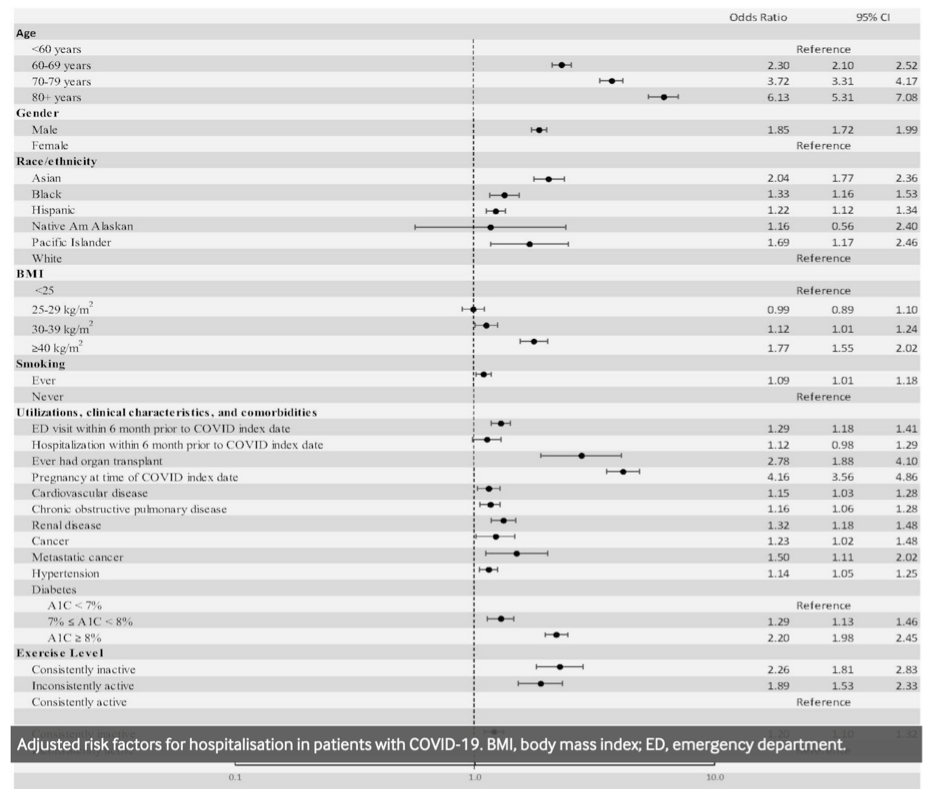| |
Physical inactivity is associated with a higher risk for severe COVID-19 outcomes: a study in 48 440 adult patients
|
| |
| |
Download the PDF here
https://bjsm.bmj.com/content/early/2021/04/07/bjsports-2021-104080?utm_source=adestra&utm_medium=email&utm_campaign=usage&utm_content=monthly&utm_term=4-2021
April 13 2021 British Jnl of Sports Medicine
Patients with COVID-19 who were consistently inactive had a greater risk of hospitalisation (OR 2.26; 95% CI 1.81 to 2.83), admission to the ICU (OR 1.73; 95% CI 1.18 to 2.55) and death (OR 2.49; 95% CI 1.33 to 4.67) due to COVID-19 than patients who were consistently meeting physical activity guidelines. Patients who were consistently inactive also had a greater risk of hospitalisation (OR 1.20; 95% CI 1.10 to 1.32), admission to the ICU (OR 1.10; 95% CI 0.93 to 1.29) and death (OR 1.32; 95% CI 1.09 to 1.60) due to COVID-19 than patients who were doing some physical activity.
The US Physical Activity Guidelines call for all adults to engage in at least 150 min/week of moderate to vigorous physical activity (MVPA).3Similar guidelines have been promoted in many countries based on strong evidence that regular PA results in a broad range of health benefits.4-6 It is reasonable to expect regular PA may mitigate poor COVID-19 outcomes. It is well known that immune function improves with regular PA, and those who are regularly active have a lower incidence, intensity of symptoms and mortality from various viral infections.7-9 Regular PA reduces the risk of systemic inflammation, which is a main contributor to lung damage caused by COVID-19.10 Additionally, exercise benefits cardiovascular health, increases lung capacity and muscle strength, and improves mental health.3 11 These are mechanisms by which regular PA could play an important role in mitigating the severity of the COVID-19 pandemic, in addition to its beneficial effects on multiple chronic diseases.
Three categories of PA were created for this study based on the US Physical Activity Guidelines3: consistently meeting guidelines (EVS >150 min/week at all assessments during the study period), consistently inactive (EVS 0-10 min/week at all assessments) and some activity (EVS 11-149 min/week or those with variability in their EVS measures).

Abstract
Objectives To compare hospitalisation rates, intensive care unit (ICU) admissions and mortality for patients with COVID-19 who were consistently inactive, doing some activity or consistently meeting physical activity guidelines.
Methods We identified 48 440 adult patients with a COVID-19 diagnosis from 1 January 2020 to 21 October 2020, with at least three exercise vital sign measurements from 19 March 2018 to 18 March 2020. We linked each patient’s self-reported physical activity category (consistently inactive=0-10 min/week, some activity=11-149 min/week, consistently meeting guidelines=150+ min/week) to the risk of hospitalisation, ICU admission and death after COVID-19 diagnosis. We conducted multivariable logistic regression controlling for demographics and known risk factors to assess whether inactivity was associated with COVID-19 outcomes.
Results
Patients with COVID-19 who were consistently inactive had a greater risk of hospitalisation (OR 2.26; 95% CI 1.81 to 2.83), admission to the ICU (OR 1.73; 95% CI 1.18 to 2.55) and death (OR 2.49; 95% CI 1.33 to 4.67) due to COVID-19 than patients who were consistently meeting physical activity guidelines. Patients who were consistently inactive also had a greater risk of hospitalisation (OR 1.20; 95% CI 1.10 to 1.32), admission to the ICU (OR 1.10; 95% CI 0.93 to 1.29) and death (OR 1.32; 95% CI 1.09 to 1.60) due to COVID-19 than patients who were doing some physical activity.
Conclusions Consistently meeting physical activity guidelines was strongly associated with a reduced risk for severe COVID-19 outcomes among infected adults. We recommend efforts to promote physical activity be prioritised by public health agencies and incorporated into routine medical care.
Demographics
The population had a mean age of 47.5 years (SD 17.0), with a median of 47 years (IQR 33.0, 60.0) and included 61.9% females (table 1). 6.4% were consistently meeting PA guidelines and 14.4% were consistently inactive, with the remainder falling in the some activity category. White patients were most likely to consistently meet PA guidelines (9.4%), followed by Asian patients (7.3%), Hispanic patients (5.5%) and African-American patients (4.6%). The mean BMI was 31.2 (SD 7.07). 51.4% of the study cohort had no comorbidities while 17.4% had only one, and 31.3% had two or more. The percentage of those who were consistently meeting PA guidelines was lower among those with chronic diseases (including obesity) and those who smoked.
Among all patients with COVID-19, 8.6% were hospitalised, 2.4% were admitted to the ICU and 1.6% died (table 2). Those who were consistently meeting PA guidelines were less likely to be hospitalised, admitted to the ICU or die related to COVID-19 than those who were consistently inactive or doing some activity. In addition, a similar trend was observed for those who were doing some activity compared with those who were consistently inactive.
Methods
Study design
This is a retrospective observational study in which PA was documented in the EHR in the 2 years preceding the March 2020 pandemic lockdown.
Setting
This study was conducted at Kaiser Permanente Southern California (KPSC), which is an integrated healthcare system that serves approximately 4.7 million residents in Southern California at 15 medical centres. Racial/ethnic make-up, neighbourhood education and household income are generally similar to the area population.17 KPSC uses a comprehensive EHR that links all laboratory results, healthcare visits and diagnoses in both inpatient and outpatient settings and even outside the system.
Study cohort
Inclusion criteria consisted of KPSC health plan members aged 18 years and older with a positive COVID-19 test or diagnosis between 1 January 2020 and 21 October 2020. Participants were continuously enrolled at KPSC for at least 6 months prior to their COVID-19 diagnosis. We required patients to have at least three outpatient visits with an exercise vital sign (EVS) measure between 19 March 2018 and 19 March 2020 to increase the likelihood that the assessment captured regular PA habits.
|
|
| |
| |
|
|
|